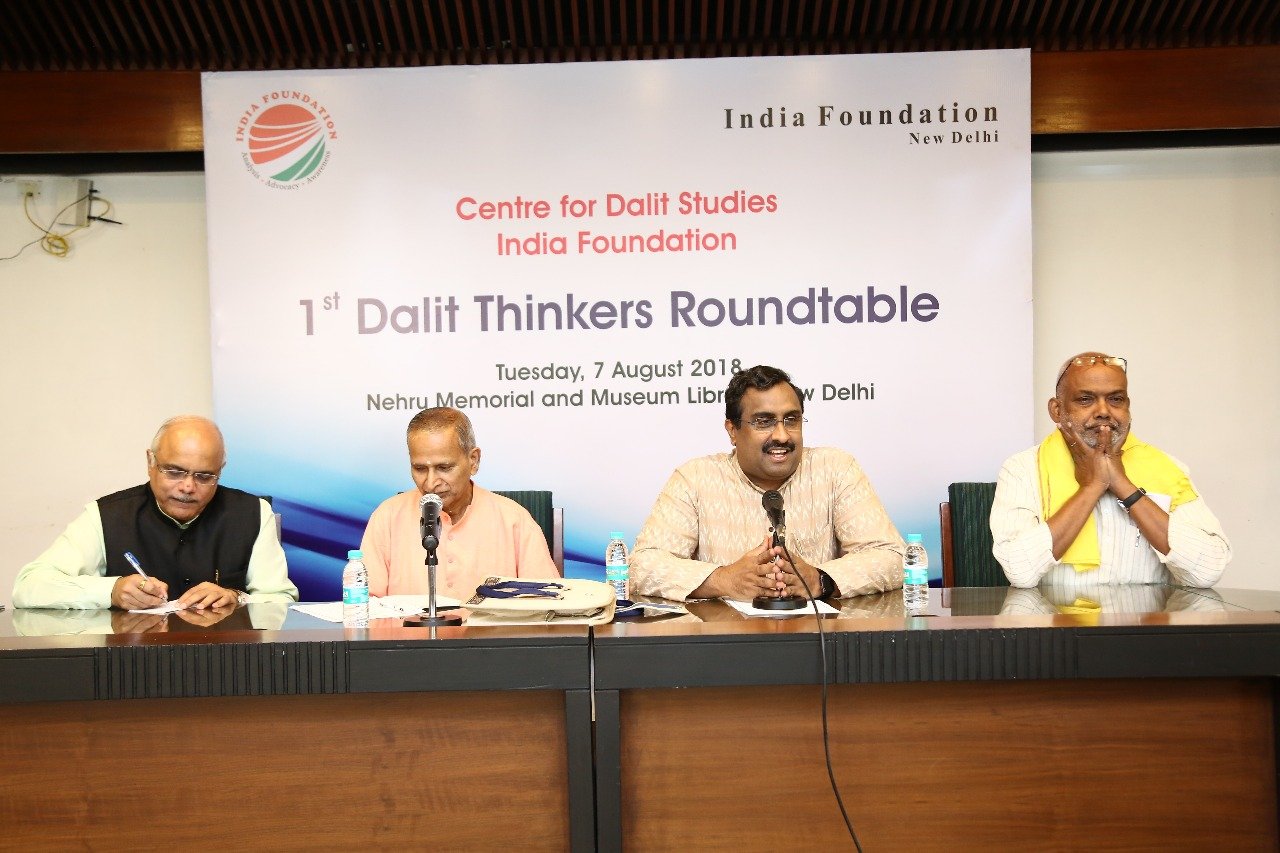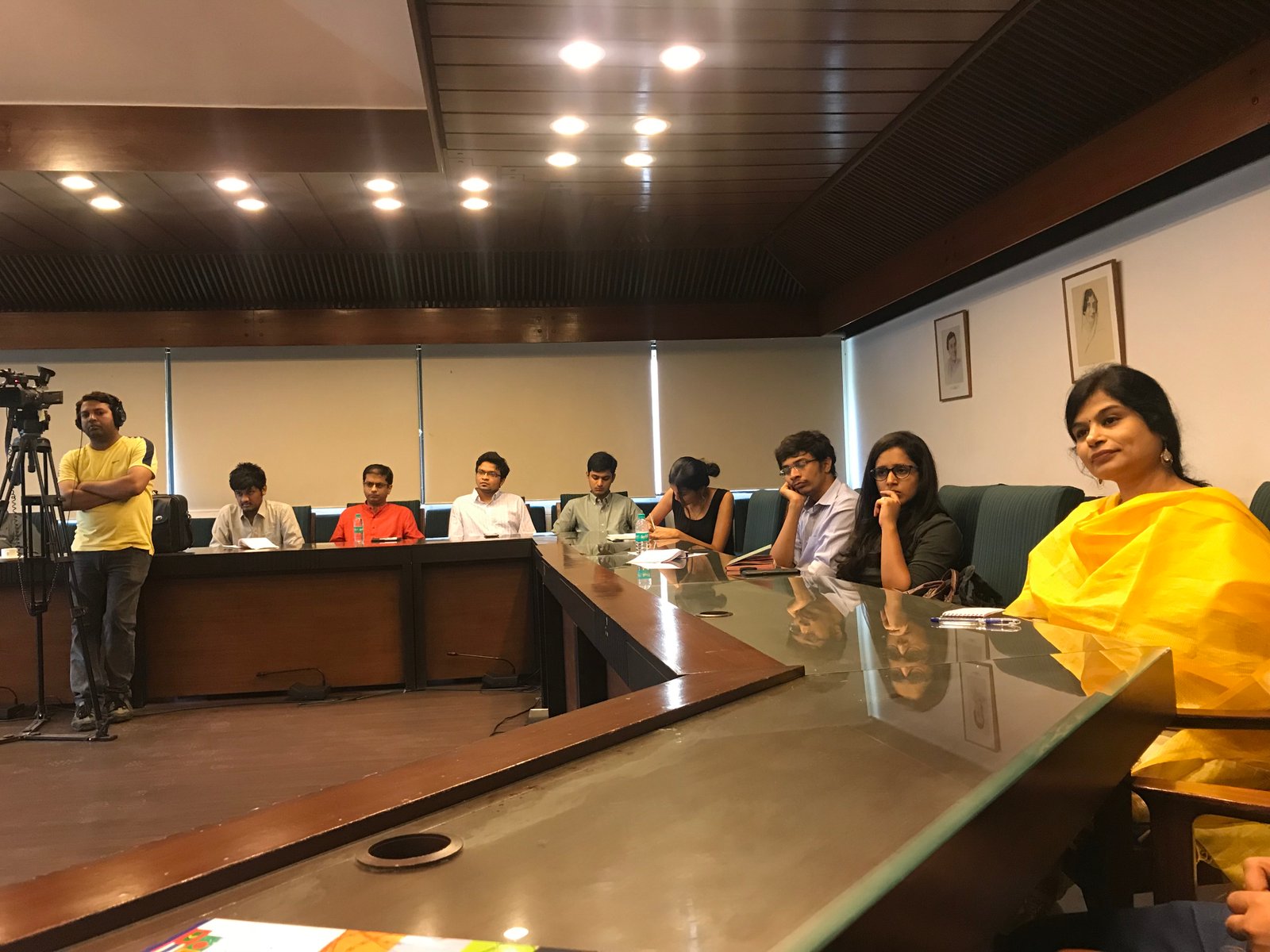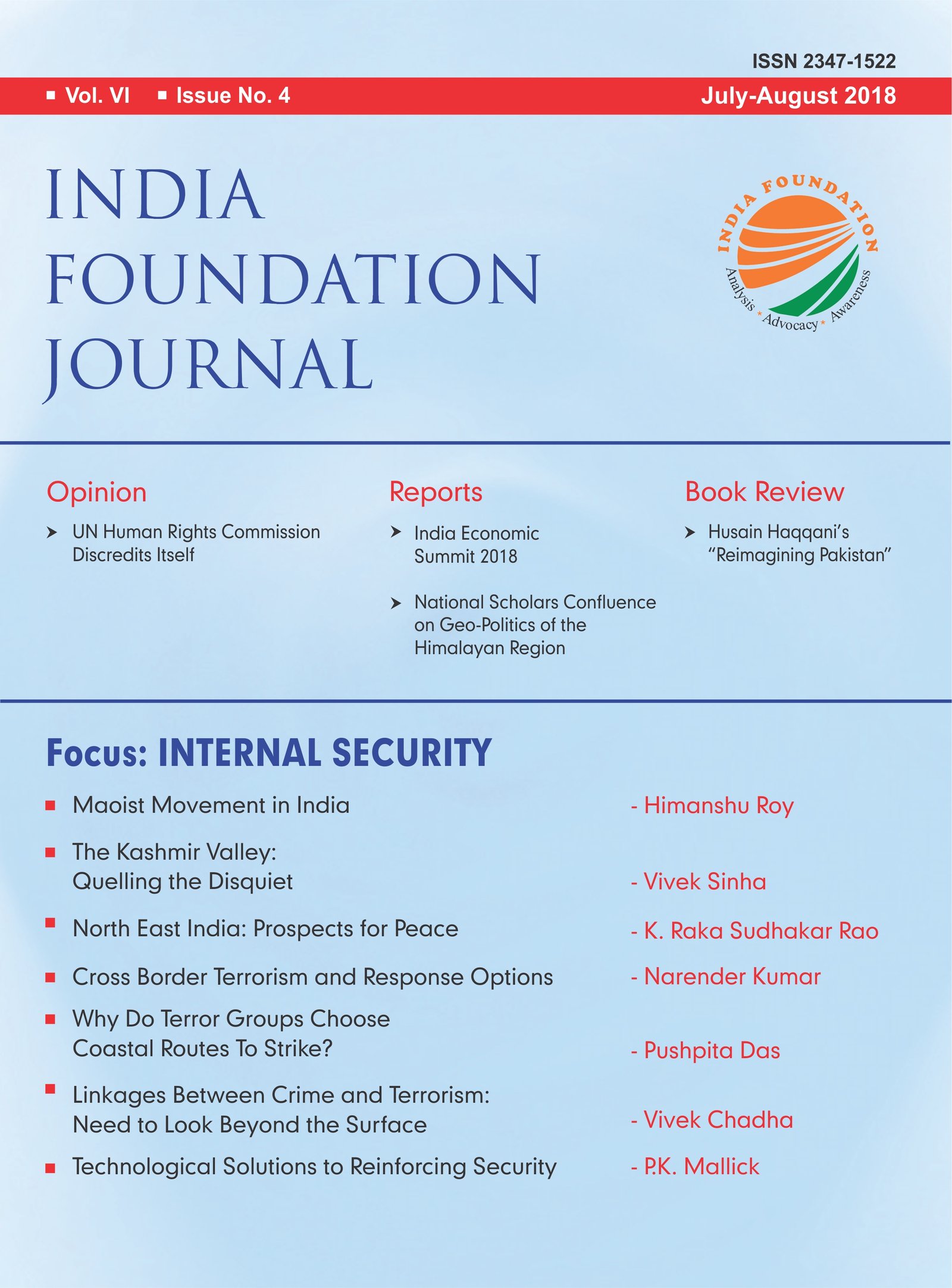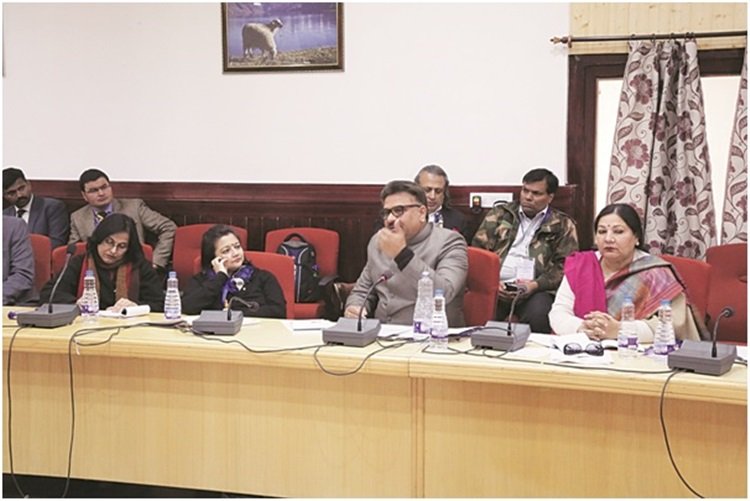The challenge of drug trafficking, fake currency, illegal migration, human trafficking and civic unrest amongst others are common law and order issues that are faced by most countries. With time, these crimes have witnessed growing sophistication, given the dramatic improvement in communications. This has brought the benefits of a globalised marketplace to criminal activities.1 Criminal groups have often been the pioneers in innovating new methods and exploring ingenious efficiencies, well before intelligence and law enforcement agencies incorporate the benefits of similar advancement. This globalised outlook of criminal groups has been facilitated by technological innovations. As an illustration, the need to physically move money through couriers is being overtaken by options to pay in cryptocurrencies like Bitcoin, even though it is still a small percentage presently.2 While these issues are common and afflict countries in varying degrees, it is the threat of these criminal activities either indirectly or directly feeding into terrorist networks that poses a much more serious challenge to countries like India. “Transnational organised crime and international terrorism increasingly share both organisational and operational characteristics, and at times even partner with one another.”3 This emanates from symbiotic interests, even if these are not shared, as would be the case in most instances. Often, the core interest of a criminal group is profitability. On the other hand, the primary interest of a terrorist organisation is driven by political or ideological motivations. However, the nexus between crime and terrorism finds active collaboration between the two. As a result, the criminal group gets business opportunities, while a terrorist organisation can employ the existing channels of crime for supporting their activities and generating the requisite funds.
It is critical to make this linkage as crime and terrorism often tend to be treated and addressed in water tight compartments by organisations that tend to function in stove-piped channels, despite being a part of the same state apparatus. This is not only true for their functioning at the tactical level, but also in terms of drafting and implementing legal provisions and collation of intelligence. As a result, agencies often tend to remain satisfied with superficial criminal proceedings resulting in light sentences, given the pursuit of peripheral offences, rather than terrorism. This results in the failure of the enforcement system to act as a deterrent and give a sense of impunity to criminal gangs, which gain the confidence to weather any legal storm that may come their way.
This article will analyse some of these threats in the context of not merely law and order, but more importantly how these crimes support terrorism. In doing so, the channels that are employed by criminal groups and terrorist networks will be examined and related with the actions initiated against them. This will indicate the adequacy, or otherwise, of the steps that have been initiated in the past and measures required to enhance focus and capacity in the context of the relation between crime and terrorism. The case studies will also link global patterns to establish evolving trends and the specific relation to India.
Drug Trafficking
Drug trafficking is a well-established criminal activity and has lucrative economies of scale. This lends it the requisite incentive for profitability and resultantly gain political influence. The economic potential of drugs arises from its production, extraction and trading. The lucrative business opportunity provided by drugs has witnessed a sharp increase in its usage, trade and production over the years. One of the foremost examples of the same is the growth trend witnessed in Afghanistan. Afghanistan survey report of United Nations Office on Drugs and Crimes (UNODC) estimates indicate that in 2017, opium poppy cultivation increased sharply to an unprecedented record high of 3,28,000 hectares from an estimated 2,01,000 hectares in 2016. This led to a raise in the potential opium production from 4,800 tons in 2016 to 9,000 tons in 2017. The value of this opiate economy was further estimated at 20-32 percent of Afghanistan’s USD 4.1-6.6 billion economy.4It is also evident from the report that the markets in Europe and the US, which are the most important consumption source for high quality drugs, have also become the indirect facilitators of terrorism. Drug trafficking and its illegal sale in these regions, might be seen merely as a law and order challenge locally, however, the profits that drug sales help generate for criminal and terrorist groups, allow organisations like the Taliban to emerge as amongst the best funded and richest terror groups in the world.
An analysis of criminal groups involved in drug related trafficking suggests that most groups which are involved in this illegal activity, are also similarly linked with other crimes like human trafficking, smuggling of weapons and other goods. A UNODC report indicates that, “Drug trafficking groups in Europe are frequently also involved in the counterfeiting of goods, trafficking in human beings, smuggling of migrants and trafficking in weapons.”5
This reinforces the trend of mutual benefit between criminal groups in Europe and the Taliban, even if there is no direct linkage between the two. Criminal groups increase their profits in Europe and this provides the incentive for the Taliban, to increase production of drugs and its trafficking from the areas under its control in Afghanistan. The Afghan example further suggests that a criminal activity like extortion, becomes a major source of funding. The 2017 UNODC survey indicates that approximately 62 percent of the farmers in Afghanistan paid some sort of a tax, ranging from 2 and 20 percent of the sale value and half of them between 4 and 10 percent. This brings the taxed amount to approximately USD 74 million. If a similar percentage is added to trafficking of opiates, it increases Taliban revenues to USD 220-350 million.6
In contrast, India does not figure as a major drug producing country. There have been limited incidents of the same, restricted to some areas in the Naxal affected areas and Northeast India. Instead, India is referred to as one of the vital links between the Golden Crescent in the west and the Drug Triangle in the east. In 2017, this saw seizure of 1,991 kg of opium, 2,189 kg heroin, 1,96,792 kg ganja, 2,657 kg hashish and 67 kg cocaine.7 The trafficking, of drugs through India allows large sums of money to be raised in the process. Since several drug routes pass through areas either under the influence of or in some cases controlled by terrorist organisations, they levy a charge on its movement.8 Border areas along Western India are also prone to smuggling of drugs, often in the form of composite loads. These take place in the form of packages that include not only drugs but also fake currency and weapons.9The market for these criminal proceeds in India, not only supports the criminal network, but also allows terrorist groups to exploit the same.
Human Trafficking
Human trafficking, despite advances in policing and border management, continues to impact the security situation in India. The figures for 2016 indicate that a total of 8,132 cases were reported. This was despite 23,000 victims being rescued including 182 foreigners. The maximum cases were reported in West Bengal at 3,579. In 2015, Assam had reported more cases than West Bengal, however these came down to 91, suggesting that a concerted effort to curb the same can yield requisite results. In 2016, West Bengal was followed by Rajasthan, Gujarat, Maharashtra and Tamil Nadu as states that witnessed the highest trafficking numbers.
Security concerns related to terrorism get linked with human trafficking, as inputs suggest the possibility of terrorist groups exploiting these channels for recruitment. The second meeting hosted by the Office of the Special Representative and Co-ordinator for Combating Trafficking in Human Beings (OSR/CTHB), underlined the instances and future possibility of “increasingly widespread phenomenon of deceptive and forced recruitment of adults and children across the OSCE region for terrorism-related exploitative practices.”10 This could be a sign of similar instances in other areas to include South Asia as well.
Fake Currency
The threat of fake currency has remained a constant source of concern for security agencies. In 2011, 98 of the 100 countries surveyed reported to the INTERPOL of the incidence of fake currencies.11 The instance of fake currency is prevalent in most major economies of the world to include the US dollar, Euro, Chinese Yuan, Swiss Franc, British Pound Sterling and the Indian Rupee. Amongst these, the Indian currency is one of the most counterfeited with 5,75,747 notes reported as counterfeited by India.12 This has since 2011 increased substantially. Financial Action Task Force research indicates that counterfeiting of currency has several adverse effects. This includes loss of trust in the currency, adverse impact on the integrity of the financial sector, linkage with drugs and other offences, linkage with finance of terrorism and as proceeds of crime. All these factors are relevant to India, especially given the motivation for introducing FICN into the Indian economy. Fake currency trade is undertaken by individuals in need of money, semi-professional and professionals. Over time, the advancement in technology has led to improved techniques and equipment availability to even amateurs, which was not the case in the past.13 However, it is the challenge posed by institutional involvement of foreign countries that poses the greatest threat. This brings together, as is the case of India, the financial and technological capability of a country like Pakistan and its intelligence services, with the criminal networks that they exploit to transfer and distribute FICN. The involvement of Pakistan has been confirmed by India in a court of law, where a judgement indicted the involvement of the Pakistani state in 2014.14 In addition, the FATF, in its report also confirms the detection of FICN in containers moved from Pakistan via Hong Kong, to Nepal, a fact confirmed by Hong Kong to the FATF.15 The involvement of the Pakistani state in producing and distributing FICN, is a trend that is reinforced through other terror groups elsewhere in the world. Chechen terrorists have been involved with the distribution of US dollars and the Russian ruble.
The Indian example brings together the crime-terrorism nexus in case of fake currency. While a state terrorist establishment in Pakistan prints and controls the supply chain, criminal groups are involved in the induction and distribution network inside India. This not only funds terrorist activities inside the country, but also creates a profit venture for criminal groups.
One of the measures that was undertaken to disrupt the currency in circulation was the decision to demonetise the 500 and 1,000 rupee notes in 2016. This decision did have an immediate impact on the financing of terrorism. The hawala dealers, who were the biggest conduit for cash into India, were suddenly left with large sums, which were difficult to exchange. Terrorist group war chests were affected, as indicated by the sudden reduction in stone throwing in J&K and the decision of terrorist groups to resort to criminal activities like looting cash vans.16 Similarly, groups in Northeast India and Naxal zones with large amounts of stacked currency were placed in a challenging situation.17 The success of the initiative hinged on two elements. First, a stringent control on the receipt of currency in banks and second, scrutiny of fake currency while doing so. Initial indicators suggest that a subsidiary element, which is critical for success of enforcement actions constrained the success of the initiative. This was the adverse impact of corruption and weak enforcement at the functional level.18A recent report suggests that the instance of fake currency reports increased by 3.22 lakhs in 2016-2017, the year demonetisation was undertaken. The report claimed, “A noteworthy growth was also seen in the number of counterfeit currency reports (CCRs), which increased from more than 4.10 lakh in 2015-16 to over 7.33 lakh in 2016-17, which may also be attributed to the demonetisation exercise.”19
Civic Unrest
The linkage of civic unrest as an instrument of creating an internal security challenge must be related to not only stoking mob violence in a state like J&K, but also to fomenting unrest in other areas of the country to create or further discord and dissension.
It has been documented with a degree of accuracy and in reasonable detail, how violent mobs have been employed to mislead the youth and create a situation that fuels a cycle of violence in J&K. The conditions that have emerged in the state, clearly indicate how law and order situations like street protests, facilitates, encourages and provides a fillip to terrorism. Under normal conditions, a 14-year-old throwing stones and protesting might be seen as the pent-up anger of youth and may not even enter police records. However, the very same activity, when employed as an instrument of direct and indirect abetment to terror acts, becomes a serious concern. There have been instances in J&K, where terrorists have managed to escape cordons laid by security forces. In other cases, security force personnel have received grave injuries as well.20
In yet another instance of crime and terrorism acting in concert, several schools were burnt in J&K.21The intent of the action became clear by the location of these institutions, which coincided with an increase in terror related violence in South Kashmir. Further, the targeting of primarily government schools instead of both government and private institutions, indicated an intent to destroy state infrastructure, even as private local investment remained safe.22 The instances also ensured that children who would have otherwise remained engaged with academics, were now forced to become an instrumentality for stone throwing on the streets of the state.
The instances of civic unrest are not only peculiar to disturbed areas like J&K, but also other areas where social cleavages can be created and widened. These instances like the Kudankulam protests against the nuclear plant, clearly highlighted how interested groups could exploit local sentiments through misinformation and misrepresentation of facts for furthering their parochial interests.23 The possibility of generating and exploiting similar social conditions, fuelled by caste divides, as was the case with dalit protests in Maharashtra, Patel protests in Gujarat, river water disputes between Karnataka and Tamil Nadu, communal situations in Uttar Pradesh cannot be ruled out in the future. These are all examples of situations that can move beyond law and order challenges driven by criminals, to internal security threats if not scrutinised for the possibility in time.
Concluding Observations
Internal security was and shall remain a challenge in the years to come. However, it is the growing complexity and sophistication of the means adopted by adversaries, criminals and terrorists alike, that has changed the character of the threat. Much like war, wherein, its nature remains the same, even as its character changes, internal security challenges too have evolved with increasing regularity. The inflection point for this change is brought about by the same factors as was the case in the past. This article highlights two of these: corruption and technology, since the growing impact of these factors has made emerging challenges more pervasive and difficult to discern.
Crime, money laundering and terrorism need an ideal breeding ground, which creates the requisite conditions that can facilitate exploitation of structures and systems in place. This is not peculiar for India or South Asia and is a universal condition. It only varies in the degree and extent of its contributory impact. As an illustration, a UNODC report indicates that successful movement of drugs through its supply chain is made possible by corruption at every level. “At the production level, farmers may bribe eradication teams, producers may bribe judges and police officers, and manufacturers may exploit workers in chemical companies in order to get hold of precursor chemicals. Further down the chain, traffickers bribe custom officials and take advantage of weaknesses in transport firms. At the consumer level, users can get drugs through corrupt doctors and pharmacists.”24
An example of corruption in the banking system adversely affecting the success of demonetisation was earlier highlighted in the article. This instance demonstrated the result of complicity of a few officials within the system, willing to subvert it, thereby limiting the intended effect of the decision.
The second constituent that deserves emphasis is technology. This is a double-edged sword. It can both deny an opportunity to criminals by making the systems transparent and accountable. Simultaneously, if the criminals and terrorists remain ahead of the curve, which is often the case, then technology becomes the biggest threat since it creates a sophisticated adversary, with the ability to successfully subvert existing instruments of intelligence and enforcement.
It is beyond the scope of this paper to enunciate a detailed roadmap to address the challenges highlighted. However, five areas of emphasis emerge from the threats and challenges that deserve attention. First, there is a thin line between crime and terrorism. It is imperative for intelligence and enforcement agencies to constantly remain vigilant for this possibility. The state must empower them to deal with the threat accordingly through the necessary legal framework. Second, even as major wars recede in their probability, the possibility of lesser constituents like terrorism, subversion and civic unrest could gain further in significance. Rather than seeing these as isolated incidents, the threats must be recognised as part of a larger pattern, which has the footprint of known adversaries. Third, given the integration of various constituents of hybrid war by the adversary requires that all elements of the state must function with equal if not more cohesiveness as part of an all of government approach. Fourth, electronic trails will become the most important linkage for tracing crime and terrorism. This is especially related to financial linkages, which can be established better through the digitisation initiative that is underway. Fifth, capacity building which remains a perpetual constraint, must not only be addressed in terms of numbers, but more importantly by increasing capabilities that focussed threat-based training can provide.
References:
1 “Organised Crime”, UNODC, http://www.unodc.org/unodc/en/organized-crime/intro.html, accessed on May 22, 2018.
2 “The Drug Problem and Organized Crime, Illicit Financial Flows, Corruption and Terrorism”, World Drug Report 2017, UNODC, May 2017, http://www.unodc.org/wdr2017/field/Booklet_5_NEXUS.pdf, accessed on May 23, 2018, p 9.
3 Thomas M. Sanderson, “Transnational and Organized Crime: Blurring the Lines”, SAIS Review Vol. XXIV no. 1 (Winter – Spring 2004),http://www.shirleymohr.com/JHU/Sample_Articles_JHUP/SAI_2004_24_1.pdf, accessed on May 22, 2018, p. 49.
4 “Afghanistan Opium Survey 2017: Challenges to Sustainable Development, Peace and Security” United Nations Office on Drugs and Crime, May 2018, https://www.unodc.org/documents/crop-monitoring/Afghanistan/Opium-survey-peace-security-web.pdf, accessed on May 23, 2018, p. 4.
5 “The Drug Problem and Organized Crime, Illicit Financial Flows, Corruption and Terrorism”, World Drug Report 2017, n. 2, p 9.
6 “Afghanistan Opium Survey 2017: Challenges to Sustainable Development, Peace and Security” n. 4, p. 9.
7 “India’s location makes it vulnerable to narcotic drug trafficking: Rajnath Singh”, The New Indian Express, March 24, 2018, http://www.newindianexpress.com/nation/2018/mar/24/indias-location-makes-it-vulnerable-to-narcotic-drug-trafficking-rajnath-singh-1791976.html, accessed on June 3, 2018.
8 Bikash Singh, “Intelligence inputs say militant outfits in North East trading opium”, The Economic Times, January 26, 2016, https://economictimes.indiatimes.com/news/politics-and-nation/intelligence-inputs-say-militant-outfits-in-north-east-trading-opium/articleshow/50727295.cms, accessed on June 03, 2018.
9 VivekChadha, “Terrorism Finance: Sources and Trends in India”, Journal of Defence Studies, Vol. 8, No. 3, July-September 2014, p 70.
10 “Second expert meeting on trafficking in human beings for terrorist activities concludes in London”, Office for Security and Cooperation in Europe, February 20, 2018, https://www.osce.org/secretariat/373001, accessed on May 25, 2018.
11 “Money Laundering and Terrorist Financing Related to Counterfeit Currency”, FATF, June 2013, http://www.fatf-gafi.org/media/fatf/documents/reports/money-laundering-terrorist-financing-related-to-counterfeit-currency.pdf, accessed on May 24, 2018, p. 13.
12 Ibid, p. 14.
13 Ibid, p. 15.
14 VivekChadha, Lifeblood of Terrorism: Countering Terrorism Finance, Bloomsbury, New Delhi, 2015, p. 71.
15 “Money Laundering and Terrorist Financing Related to Counterfeit Currency”, FATF, June 2013, http://www.fatf-gafi.org/media/fatf/documents/reports/money-laundering-terrorist-financing-related-to-counterfeit-currency.pdf, accessed on May 24, 2018, p. 18.
16 J&K: Militants kill 5 cops, 2 bank officials while looting cash van in Kulgam district”, The Indian Express, May 01, 2017, http://indianexpress.com/article/india/j-k-terrorists-kill-4-cops-2-bank-officials-while-looting-cash-van-in-kulgam-district-4635740/, accessed on June 04, 2018. A number of similar incidents came to light in J&K in the aftermath of demonetisation.
17 VivekChadha, “Demonetisation and Beyond: Addressing the Finance of Terrorism”, November 18, 2016, IDSA,https://idsa.in/policybrief/demonetisation-and-beyond-addressing-the-finance-of-terrorism_vchadha_181116, accessed on June 04, 2018.
18 Deepak Patel and Sunny Verma, “Demonetisation: 208 bank employees under scrutiny”, The Indian Express, February 7, 2017, http://indianexpress.com/article/business/banking-and-finance/demonetisation-208-bank-employees-under-scrutiny-rbi-4511202/, accessed on June 04, 2018.
19 “Banks received alarming amounts of fake currency post demonetisation; detected 480% jump in suspicious transactions”, Firstpost, April 20, 2018, https://www.firstpost.com/business/banks-received-alarming-amount-of-fake-currency-post-demonetisation-detected-over-480-jump-in-suspicious-transactions-4440067.html, accessed on May 24, 2018.
20 M. SaleemPandit, “1 soldier, 4 civilians killed in anti-terror operation in Kashmir”, The Times of India, April 22, 2018, https://timesofindia.indiatimes.com/india/1-soldier-4-civilians-killed-in-anti-terror-operation-in-kashmir/articleshow/63721509.cms, accessed on May 25, 2018 and “Army Chief warns of tough action against stone-throwers”, The Tribune, February 16, 2017, http://www.tribuneindia.com/news/jammu-kashmir/community/army-chief-warns-of-tough-action-against-stone-throwers/364643.html, accessed on May 25, 2018.
21 “Burning of schools: J&K government sees separatist hand”, Indian Express, October 31, 2016, http://indianexpress.com/article/india/india-news-india/burning-of-schools-jk-govt-sees-separatist-hand-3731406/, accessed on May 25, 2018.
22 Kashmir unrest: Nearly 20 schools burnt down as education becomes biggest casualty of protests”, Firstpost, October 27, 2016, https://www.firstpost.com/india/kashmir-unrest-19-schools-burnt-down-in-kashmir-in-three-months-students-languish-as-studies-suffer-3075590.html, accessed on May 25, 2018.
23 Kaipullai, “Kudankulam protests: Highjacked by the church and the foreign hand?”,Firstpost, March 26, 2012, https://www.firstpost.com/india/kudankulam-protests-hijacked-by-the-church-and-the-foreign-hand-255466.html, accessed on May 26, 2018.
24 “The Drug Problem and Organized Crime, Illicit Financial Flows, Corruption and Terrorism”, World Drug Report 2017, n. 2, p 10.
(Col. VivekChadha (Retd) is a Research Fellow at the Institute for Defence Studies and Analyses (IDSA),
New Delhi. He has written extensively on the financing of terrorism in India and is the author of
the book ‘Lifeblood of Terrorism: Countering Terrorism Finance.’)
(This article is carried in the print edition of July-August 2018 issue of India Foundation Journal.)























